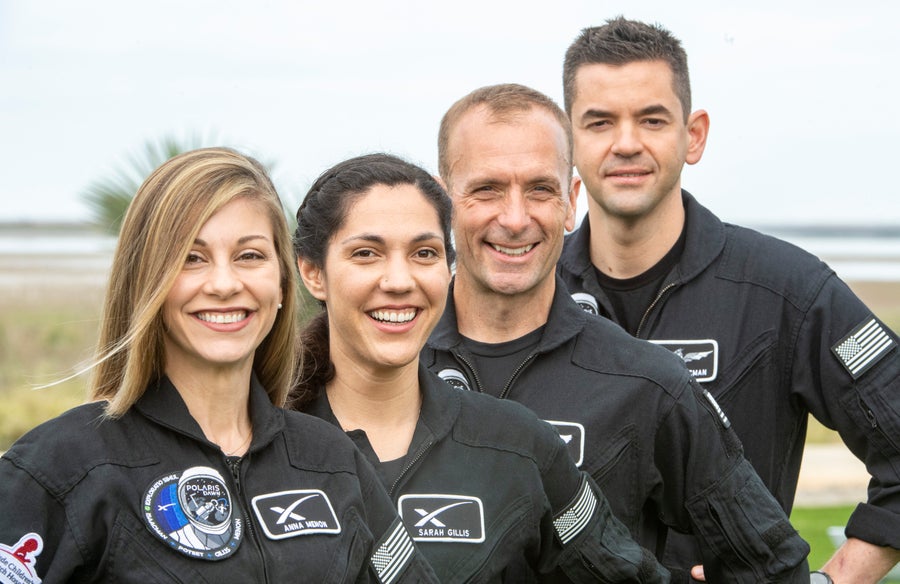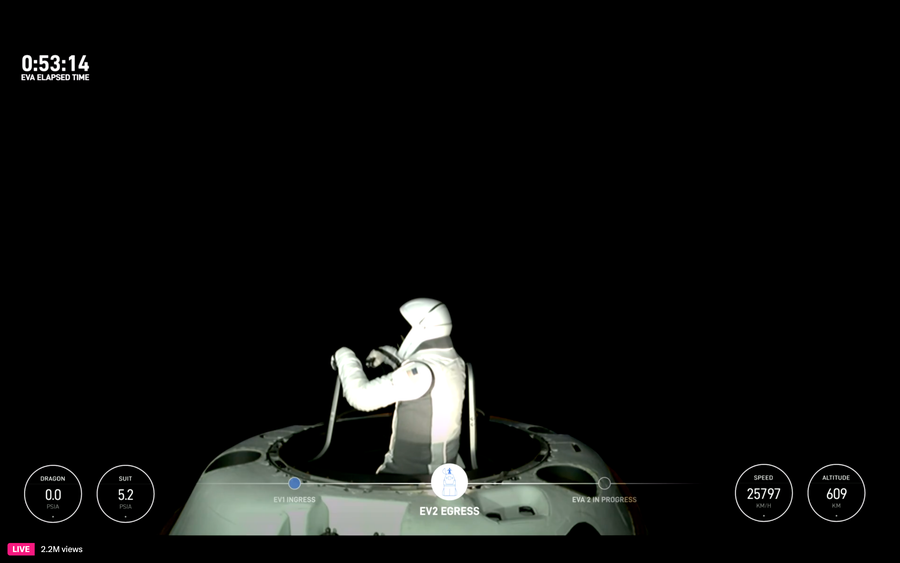It wasn’t a small step—more a clamber, really—but as billionaire entrepreneur Jared Isaacman climbed partway out of a SpaceX Dragon capsule located nearly 740 kilometers above Earth on early Thursday morning, he made a giant leap into spaceflight history.
That’s because Isaacman is a private citizen who is flying in a commercial spacecraft on a voyage he paid for—not a government-agency astronaut on a taxpayer-funded trip like every space walker before him. Conceived in collaboration with Elon Musk’s SpaceX and launched atop one of the company’s Falcon 9 rockets on Tuesday, Isaacman’s five-day Polaris Dawn mission is the first of three journeys that have been planned to advance the state of the art in human spaceflight. The mission is also raising money for St. Jude Children’s Research Hospital.
Polaris Dawn had already marked its first historic milestone mere hours after launch when it fired Dragon’s thrusters to raise the spacecraft’s swooping elliptical orbit and reached more than 1,400 kilometers in altitude at its peak. That’s the farthest from Earth any human has ventured since the 1970s, when the last of the Apollo lunar missions left the entire planet in the rearview on the way to the moon. And on Wednesday, after six orbits at that dizzying height—which exposed the crew to higher levels of cosmic radiation and an elevated risk of encounters with hazardous space debris—the Dragon fired its thrusters again to push itself into a lower, safer orbit, where the space walk would take place.
On supporting science journalism
If you’re enjoying this article, consider supporting our award-winning journalism by subscribing. By purchasing a subscription you are helping to ensure the future of impactful stories about the discoveries and ideas shaping our world today.
Livestreamed from orbit to more than two and a half million viewers on Earth, the carefully choreographed space walk officially began at 6:12 A.M. EDT some 265 kilometers over the northern Atlantic, off the coast of Ireland, when the Polaris Dawn crew members sealed their space suits and began breathing pure oxygen. Nearly 20 minutes passed as they completed suit leak checks and other last-minute safety protocols before they began to vent air from the Dragon capsule at 6:30 A.M. By this time, Dragon’s orbital speed of more than 25,000 kilometers per hour had sent them over the vastness of the southern Indian Ocean.
With the crew speaking on open mics, choruses of confirmatory calls chirped out over the hiss of flowing air in the final moments before the fateful command radioed from the ground: “SpaceX copies. Dragon, you are ‘go’ to open hatch.”
Minutes later, at 6:51 A.M., Isaacman ascended a specially designed hand-and-foothold platform called Skywalker and peered at the planet whirling below—a cloud-streaked, sunlit stretch of open ocean between Australia and Antarctica. Dragon’s high speed was rapidly carrying the spacecraft into orbital night, a great shadowy dividing line draped across the globe.
“Back at home, we all have a lot of work to do,” Isaacman said as he stood on the threshold of the void, gazing down at the edge of darkness and light. “But from here, Earth sure looks like a perfect world.”
Touching the Void
The primary purpose of the space walk, conducted on the mission’s third day in orbit, was to showcase and test brand-new extravehicular activity (EVA) suits that were designed and manufactured by SpaceX. These black-and-white suits evolved from the company’s earlier, less protective garb for astronauts living and working inside spacecraft and space stations. The new versions include enhancements such as flexible joints for better mobility, thermal controls for astronaut comfort and a helmet with a digital heads-up display. Besides their use in EVAs for spacecraft maintenance and on-orbit servicing, the suits could someday support astronauts on trips to the moon—or could even help fulfill the vision of SpaceX’s founder, Musk, for developing sustainable human settlements on Mars.
“The ultimate goal is that you can put on the space suit and go out and get work done anywhere in the solar system and not feel like you’re wearing anything more than you normally wear every day,” said Chris Trigg, SpaceX’s senior manager of space suits, in a video showcasing them on X (formerly Twitter).

The crew of Polaris Dawn. From left to right: Anna Menon, Sarah Gillis, Scott Poteet and Isaacman.
Jonathan Newton/The Washington Post/Getty Images
Because the Dragon has no airlock, the space walk involved exposing the entire crew cabin to the airless vacuum of space. That required all four of the Polaris Dawn crew—Isaacman, along with retired U.S. Air Force pilot Scott Poteet and two SpaceX engineers, Sarah Gillis and Anna Menon—to don the suits during the two-hour space walk period. It also required an extensive “prebreathe protocol” that began shortly after liftoff. In that procedure, the crew cabin’s air pressure gradually decreased while the air’s oxygen content rose. This reduced levels of nitrogen in the crew members’ blood, minimizing the chance they would come down with decompression sickness, a potentially fatal malady also called “the bends.”
The mission plan called for only Isaacman and Gillis to leave the Dragon’s confines, taking 10-minute turns to peek out at the starry firmament and the world whirling far below. Menon and Poteet stayed behind for the duration, monitoring the spacecraft’s health and wrangling the trailing 3.5-meter-long life-support umbilicals that provided oxygen, power and other essentials to the spacewalking pair.
“You only have so much time outside…. You only have so many consumables,” said Michael Hopkins, a U.S. Space Force colonel and former spacewalking NASA astronaut, who joined two other commentators on the SpaceX livestream of Isaacman’s historic feat. “It is nice when you’re out there once in a while to take a moment, look around, enjoy the views, kind of try and absorb where you actually are.”
Those moments proved fleetingly brief. The minutes flashed by as Isaacman performed a series of movements while standing on Skywalker, testing the EVA suit’s mobility and flexibility in space. At one point, firmly anchored to footholds, he lifted both hands free of Skywalker almost as if to soar away. But by 7:00 A.M. EDT his time was up, and he had climbed back inside.

In this screenshot from the livestream, Gillis, a SpaceX engineer, stands partway outside Polaris Dawn’s Dragon spacecraft during her space walk over Earth’s night side.
Now it was Gillis’s turn. As she rose to exit the vehicle, she inspected the crucial air-preserving, life-sustaining seal on the Dragon’s hatch, finding three small bulges around its edge. By 7:05 A.M. she had mounted Skywalker. The spacecraft was passing over nocturnal terrain, and she performed her own suit mobility demonstration as a sunlit figure against a dark background. Returning to the safety of the capsule, she manually adjusted the seal bulges, pushing them back into place. Shortly after 7:15 A.M. she closed the hatch, and Dragon began its repressurization.
A quarter-hour later, as air pressure within the capsule returned to normal, it was approaching the coast of southern California and poised to poetically pass over SpaceX headquarters in Hawthorne, Calif.
Space Walk Success
The majestic view from on high had been to die for. Thankfully, however, it didn’t come to that. All of the crew members had endured rigorous training and seemingly endless simulations, but only Isaacman had previously been to space (on his Inspiration4 mission with SpaceX in 2021)—and the new EVA suits had been unproven on-orbit.
“We’re going to do it as safely as we can,” said Bill Gerstenmaier, vice president of build and flight reliability at SpaceX and former head of NASA’s human spaceflight program, during a press briefing last month. “We’ve got the right protocols, and we’ve done the right testing to get ready to go.”
But even the best-laid plans can go awry. According to Jonathan Clark, a physician at Baylor College of Medicine, who has served as a NASA flight surgeon and space suit consultant, out of the more than 475 space walks ever conducted, about one in five have encountered problems—many of which can easily become life-threatening. The very first space walk, performed by cosmonaut Alexei Leonov in 1965, was cut sort when Leonov’s space suit blew up like a balloon, jeopardizing his ability to squeeze back inside his spacecraft. NASA astronaut Ed White had an easier time of it in the first U.S. space walk during the Gemini 4 mission of 1965. But a follow-up by NASA’s Eugene Cernan in 1966’s Gemini 9 ended prematurely when the overexerted astronaut’s profuse sweating fogged his helmet as he struggled to wield an experimental rocket propulsion unit. Moisture has posed mortal risks more recently, too. During a spacewalk outside the International Space Station in 2013, European Space Agency astronaut Luca Parmitano almost drowned in his space suit after water leaking from its cooling system pooled in his helmet.
For Polaris Dawn’s space walkers, the only apparent troubles during the livestream were the bulging hatch seals. By 7:53 A.M., the cabin had fully repressurized. Five minutes later, with the crew members strapped back in their seats and the gunpowder smell of space fresh in the cabin, the space walk was declared officially complete. The crew—as well as mission controllers on the ground—could breathe easier once more.
While their most nail-biting moments now appear to be past, the Polaris Dawn astronauts have more in store before their mission comes to an end. On Friday—the mission’s fourth day in space—the crew plans to test a laser-based communications system for SpaceX’s Starlink satellites and other spacecraft. The findings will be added to a treasure trove of results from 36 other science experiments carried out onboard. These also include magnetic resonance imaging (MRI) scans of the brains of the astronauts’ brains, as well as x-ray images produced by natural cosmic radiation streaming through their bodies.
From there, the remainder of the crew members’ time will be devoted to preparing for the journey home. On the morning of day six they will once again slip into their space suits, and the Dragon will perform a deorbit burn. It will plummet through Earth’s atmosphere to splash down off the coast of Florida, where the astronauts and their spacecraft will be retrieved by awaiting recovery ships.
Editor’s Note (9/12/24): This article was edited after posting to correct the description of Ed White’s space walk in 1965, Eugene Cernan’s first name and the exact wording of remarks made during the Polaris Dawn mission.
